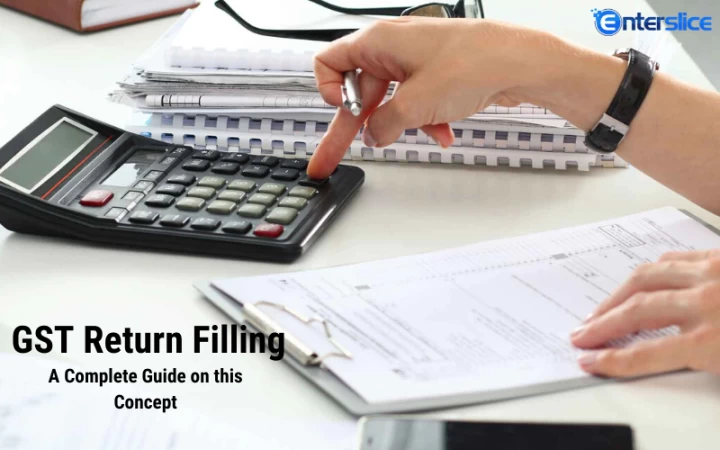In India, the Goods and Service Tax (GST) law now administers the significant portion of the indirect tax system. The suppliers registered under this act are required on a regular basis to fulfill the prescribed compliance requirement. Based on the business affairs and the annual turnover, the requirements together with the period of filing returns are specified under the law.
Goods and Service Tax (GST) Return Filing is obligatory compliance for every business registered under the Goods and Service Tax (GST) Act. As per this act, filing of GST returns is an essential requirement, as it works as a linkage between the government and the taxpayer.
While filing the GST return, the taxpayer has to give all the required information such as the details of the business affairs, declaration of tax liability, payment of taxes and other information as required by the government. Further, the GST Returns are required to be filed electronically on the GST portal. However, the facility of manual filing of the GST return is also available. These returns are prepared offline and are then uploaded to the GSTIN portal either by the taxpayer or by the facilitation center.
Further, any person who goes for the GST registration will have to file the GST return. Furthermore, the GST return is mainly a document which is required to be filed as per the Indian tax authorities of the law. Lastly, this document will be used by the tax authorities to compute the tax liability.
With the online filing of the GST return, the taxpayers share with the Goods and Service Tax Network (GSTN) about the inflow and outflow of supplies together with the amount of tax paid and collected. Along with the recording of the taxable transactions with the Government, the taxpayer is also obligated to pay the tax amount collected from an outward supplier of goods or services after the deduction of ITC (Input Tax Credit).
Who are all obligated to file the GST Return?
Every holder of the GST registration who is taxable under the Goods and Service Tax Act, 2017 is needed to file the GST returns based on the nature of the concerned business. Hence, whether the individual concerned is engaged in the selling of goods or rendering services to others, he or she must obtain the GST registration and file the returns concerned periodically.
Under the Goods and Service Tax Act, a registered dealer involved in any of the following activities needs to file the GST return:
- Sales
- Purchase
- Output GST (on Sales)
- Input Tax Credit (ITC) together with the GST paid on the purchase.
Who are all not obligated to file the GST Return?
If in case the business turnover of the registered GST holder is below the prescribed limit of rupees forty lakh, then the concerned GST holder will not be required to file his GST returns. However, those individuals, whose business is located in the North-Eastern and hilly regions and the annual turnover is below the threshold limit of rupees twenty lakhs, then the person concerned is not required to file the GST returns.
What are the Benefits of Filing GST Return?
Following are the benefits annexed with the filing of the GST Return –
- Elimination of the Cascading Effect- In Indian tax system several taxes like central excise duty, customs duty, service tax and state-level value-added tax (VAT) have been removed with the commencement of the Goods and Service Tax Act. Hence, a single GST act has eradicated the cascading effect of tax on tax.
- Higher Threshold Benefits - Before the introduction of GST, value-added tax (VAT) was applicable for every business that had an annual business turnover of rupees twenty lakhs. Further, the services that saw a turnover of less than rupees ten lakhs were not required to pay service taxes.
- Startup Benefits - Earlier startups with an annual business turnover of rupees five lakh had to pay value-added tax (VAT) which would be very hard for a business during its initial stages. But, as the GST has replaced the VAT, now the businesses can set-off the service tax on their sales only.
- E-commerce for the quick supply of goods– Nowadays, the startups are making their strong presence online by offering their products and services by way of their websites. Further, under the VAT law, there were many types of VAT prescribed, and the supply of goods through online medium, i.e. E-commerce was in no way a well-defined one. For example - if a person needs to deliver his goods to various states, then he will have to first file the VAT declaration. After that, he will need to provide the required registration details, such as the trucks which deliver the goods. Furthermore, in many examples, goods end-up being seized by the tax authorities due to lack of proper documents. Hence, the GST has now eliminated all such confusing processes.
- Regulations and accountability - The pre-GST era witnessed a muddled tax filing system. At present, all taxes are paid online, and the major hassles that were a part of the tax filing system have now been eliminated in the process due to the introduction of GST. This has resulted in the industries becoming more accountable and responsible, and the tax filing laws are now better regulated than before.
What is the Procedure for Online Filling GST Return?
From the manufacturers and suppliers to the dealers and consumers, all the concerned taxpayers are obligated to file their tax returns every year with the GST department. Further, under the new GST regime, filing of the tax returns has now become automated. Furthermore, the GST returns can be easily filed online by using the software or applications provided by Goods and Service Tax Network (GSTN), this will auto-populate the details and particulars on each Goods and Service Tax (GST) Return forms. Following are the steps required for the online filing of the GST returns:
- The concerned taxpayer is required to visit the GST portal (www.gst.gov.in).
- Next, a 15-digit GST identification number will be allotted based on the taxpayer’s state code and the PAN number.
- Now, upload the invoices on the GST portal or the software. Then an invoice reference number will be allotted against each invoice uploaded.
- After uploading all the invoices, cumulative monthly return, inward return, and outward return have to be filed online. In case there are any errors or mistakes, the taxpayer has the option to correct and rectify it and refile the returns again.
- Now, file the outward supply returns in the form GSTR-1 by using the information section available at the GST Common Portal (GSTN) on or before the 10th of the following month.
- All the details of the outward supplies furnished by the concerned supplier will be made available in the form of GSTR-2A to the recipient.
- Then the Recipient concerned has to verify, validate, and modify all the details of outward supplies and is also required to file details of credit or debit notes.
- After that, the Recipient has to furnish the details of the inward supplies of all the taxable goods and services in the form GSTR-2.
- Lastly, the concerned supplier can either accept or reject the modifications made in the details of the inward supplies, which are made available by the recipient in the form GSTR-1A.
What are the different types of GST Returns applicable under the new Goods and Service Tax Law?
Following are the types of GST Returns along with their due date of filing -
RETURN FORM | WHO SHOULD FILE AND WHAT SHOULD BE FILED | DUE DATES FOR FILING RETURNS |
GSTR-1 | The registered taxable supplier should file all the details of the outward supplies of both the taxable goods and services as affected. | 10th of the following month. |
GSTR-2 | The registered taxable recipient should file all the details of the inward supplies of both the taxable goods and services claiming ITC (input tax credit). | 15th of the following month. |
GSTR-3 | The registered taxable person should file his monthly return based on the finalization of details of the outward supplies and the inward supplies plus the payment of the tax amount. | 20th of the following month. |
GSTR-4 | Composition supplier is required to file quarterly return | 18th of the month following the quarter. |
GSTR-5 | Return for the non-resident taxable person. | 20th of the following month. |
GSTR-6 | Return for the input service distributor. | 13th of the following month. |
GSTR-7 | Return for the authorities carrying out the tax deduction at source. | 10th of the following month |
GSTR-8 | E-commerce operator or the tax collector should file all the details of the supplies effected and the tax amount collected. | 10th of the following month |
GSTR-9 | The registered taxable person should file the annual return. | 31st December of the next financial year. |
GSTR-10 | The taxable person whose registration either has been cancelled or surrendered should file the final return. | Within three months from the date of cancellation or the date of the cancellation order, whichever is later. |
GSTR-11 | The person having the UIN claiming refund should file the details of the inward supplies. | 28th of the month, subsequent the month for which the concerned statement was filed. |
What are the Various Types of GST Forms?
The GST return can be filed by using different GST forms depending upon the type of transaction and the registration of the taxpayer. Following are the return forms for normal taxpayers –
- GSTR 1 – The GSTR-1 return form has to be filed by the registered taxable supplier with all the details and particulars of the outward supplies of goods and services. Further, this form is filled by the concerned supplier. Then the buyer has to validate the auto-populated purchase details and information available on the form and make modifications if required. The concerned form will contain the following details and particulars -
- Business name, the period for which the return is filed, and the Goods and Services Taxpayer Identification Number (GSTIN)
- All the invoices issued in the preceding month together with the corresponding taxes collected
- Total advance received against the supply order that has to be delivered in the future
- Revision in the outward sales invoices from the preceding tax periods
- GSTR-1 form has to be filed by 10th of the subsequent month.
- GSTR 2 – The GSTR-2 return form has to be filed by the registered taxable recipient together with all details of the inward supplies of goods and services. Further, the form will include the following details:
- Business name, the period for which the return is filed, and the Goods and Services Taxpayer Identification Number (GSTIN)
- All the invoices issued in the preceding month together with the corresponding taxes collected
- Total advance received against the supply order that has to be delivered in the future
- Revision in the outward sales invoices from the preceding tax periods
- GSTR-2 form has to be filed by 15th of the subsequent month
- GSTR 3– The GSTR-3 return form has to be filed by the registered taxpayer together with the details that are automatically populated by the return form GSTR-1 and GSTR-2. Next, the taxpayer has to verify, validate and make modifications, if any. Lastly, the GSTR-3 return form will include the following details –
- Details about the Input Tax Credit (ITC), liability, and cash ledger.
- Details of the tax paid under the CGST, SGST, and IGST
- Claim the refund of the excess payment made or request to carry forward the credit.
- GSTR-3 has to be filed by 20th of the subsequent month.
- GSTR 4– TheGSTR-4 return form has to be filed by those taxpayers who have chosen for the Composition Scheme. Further, the taxpayers with small business or annual turnover of up to rupees seventy-five lakh can opt for the Composition Scheme in which he or she has to pay the tax at the fixed rate, decided on the basis of the business type. Furthermore, the taxpayers under this scheme will not have the input tax credit (ITC) facility. Lastly, the GSTR-4 quarterly return form will include the following details –
- The total value of the consolidated supply made during the period of return
- Details of the Tax Paid
- Invoice- level purchase details
- GSTR-4 has to be filed by the 18th of the subsequent month.
- GSTR 5– The GSTR-5 return form has to be filed by all the registered non-resident taxpayers. Further, this form will include the following details –
- Name and address of the taxpayer together with the GSTIN and the period of return
- Details of both the outward supplies and inward supplies
- Details of the goods imported, along with any amendments made in goods imported during the preceding tax period
- Import of the services, and the amendments in the import of services
- Details of the credit or the debit notes, refund claimed from cash ledger and closing stock of goods.
- GSTR-5 has to be filed by the 20th of the subsequent month
- GSTR 6– TheGSTR-6 return form has to be filed by all the taxpayers who are needed as the Input Service Distributor. Further, this form will include the following details –
- Name and address of the taxpayer, period of return, and GSTIN
- Details of the input credit distributed
- Supplies received from the registered persons
- The amount of the input credit benefited under the current tax period
- Details of the inward supplies will be automatically populated from the GSTR-1 and GSTR-5 return forms
- Details of the receiver of the input credit relating to his or her GSTIN
- Details of the credit or debit notes
- The Input tax credit (ITC) received, input tax credit lapsed, and the input tax credit distributed as the SGST, CGST, and IGST
- GSTR-6 has to be filed by the 13th of the subsequent month
- GSTR 7– TheGSTR-7 return form has to be filed by all the registered taxpayers who are needed to deduct the tax at source (TDS) under the GST rule. Further, this form will include the following details -
- Name and address of the taxpayer, period of return, and GSTIN
- TDS details and the amendments made in the invoice amount, TDS amount or the contract details
- All the details of the fees for late filing of the return and interest on the delayed payment of TDS
- Refund received from the Electronic Cash Ledger will be automatically populated.
- GSTR-7 has to be filed by the 10th of the subsequent month
- GSTR 8– TheGSTR-8 return form has to be filed by all the e-Commerce operators who are needed to collect the tax at source (TCS) under the GST rule. Further, this form will include the details of all the supplies effected and the tax amount collected under Section 43C subsection (1) of the Model GST Law. Furthermore, other details included are –
- Name and address of the taxpayer, period of return, and GSTIN
- Details of the supplies made to the registered taxable person and the amendments, if any
- Details of supplies made to the unregistered person
- Details of the Tax Collected at Source (TCS)
- TDS liability will be auto-populated.
- Details of the fees for the late filing of GST return and the interest on delayed payment of TDS
- GSTR-8 has to be filed by the 10th of the subsequent month
- GSTR 9– TheGSTR-9 return form is filed by the normal taxpayers together with the details of all the income earned and the expenditure made for the year. Further, this detail will be regrouped as per the monthly returns. Furthermore, the taxpayer will have an opportunity to make modifications in the information submitted if required. Lastly, the GSTR-9 has to be filed by the 31st December of the subsequent financial year together with the audited copies of the annual financial accounts.
- GSTR 10– TheGSTR-10 return form has to be submitted by any taxpayer who chooses for the cancellation of the GST registration. Further, this form will include the following details –
- The Application Reference Number
- Date of the cancellation of GST Registration
- The Unique ID provided for the cancellation order
- Date of the cancellation order
- Details of the closing stock including the tax amount payable on the closing stock
- GSTR 10 has to be filed within three months from the date of cancellation or the date of the cancellation order, whichever is later.
- GSTR 11– TheGSTR-11 return form has to be submitted by everyone who has been allotted a Unique Identity Number (UIN) and claims the refund of the taxes paid on the inward supplies. Further, this form will include the following details –
- Name of the concerned government entity, Unique Identity Number (UIN), and the period of return
- All the inward purchases from the GST registered supplier will be auto-populated.
- GSTR 11 has to be filed by the 28th of the month, subsequent the month for which the concerned statement was filed
How to File GST Return with the GSTN?
- The Goods and Service Tax Network (GSTN) will store information and details of all the GST registered sellers and buyers, will combine the submitted details, and also maintain registers for the future reference.
- The concerned companies are required to file three monthly returns in every three months and also one annual return in a financial year. Hence, a total of 37 returns have to be filed.
- Further, the GSTN has launched a simple and easy excel-based template to make the filing of returns simpler and easier for businesses.
- This excel workbook can easily be downloaded free of charge from the GST portal.
- Further, the taxpayers can use this template to collect the invoice data on a regular basis.
- Furthermore, all details of the inward and the outward supplies can be uploaded on the GST portal on or prior the due date.
- The data preparation can be done offline.
- Lastly, the internet facility will only be needed by the taxpayers while uploading the prepared documents on the GST portal.
What is the Penalty prescribed for the late filing of the GST Return?
A penalty will be imposed on the taxpayer in case he or she fails or defaults in filing the returns on time. The penalty imposed is called the late fee. Further, according to the GST Law, the late fee prescribed in case of the Central Goods and Services Tax (CGST) is Rs.100 for each day. The late fee is also for the State Goods and Services Tax (SGST). Therefore, the total fine amount imposed will be Rs.200 per day. However, the rate prescribed is subject to changes, which will be declared through notifications. Further, the maximum amount of fine that can be imposed is RS 5000.
It is significant to note that the Integrated Goods and Service Tax or IGST does not focus on any late fee in case of the deferred GST return filing. Further, the taxpayer will also be obligated to pay interest at the rate of 18 per cent per annum together with the late fee. Furthermore, this interest has to be computed by the taxpayer on the tax amount that is to be paid. Lastly, the time limit will be computed from the day subsequent to the filing deadline until the time when the actual payment is made.



